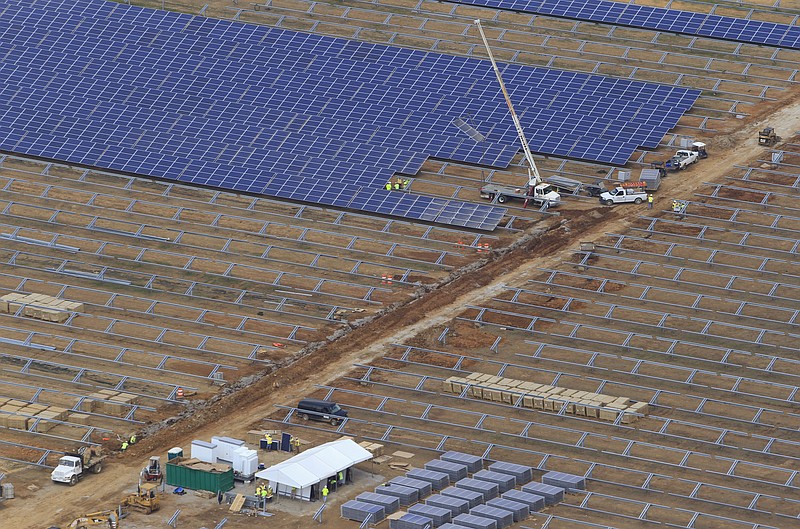New TVA CEO Jeff Lyash, a former CEO of one of Canada's biggest public utilities, thinks TVA is uniquely positioned for the challenges ahead.
Let's hope so. TVA generates the electricity that feeds most of seven states - almost the whole of the Southeast.
The real question is whether Lyash and TVA's board will institute the needed changes for the challenges ahead - those challenges being both economic and climatic.
Lyash last week told Times Free Press Business Editor Dave Flessner that the federal utility can take "a longer-term approach" to the environmental and economic changes ahead without some of the shareholder pressures of investor-owned utilities. (Longer-term, never mind the 2018 report from the United Nations Intergovernmental Panel on Climate Change that we only have about a dozen years to limit climate catastrophe.)
"Is there uncertainty? Yes. Is there risk? Absolutely. Is there going to be change? Clearly, there will be," said Lyash, a 37-year utility executive who took over as TVA's chief executive this month.
As new technologies and distributed energy generation threaten to upend the way homes and businesses get and use electricity, America's biggest government-owned utility prepares to enter its second century. TVA is is developing a new long-range power plan for the next 20 years which the TVA board will consider in August.
But one of TVA's most vocal watchdogs, the Southern Alliance for Clean Energy, isn't impressed. Earlier this month, the alliance submitted highly critical comments to TVA, proposing an overhaul of the plan and calling out TVA's lack of transparency and manipulation of data in the Draft 2019 Integrated Resource Plan.
"TVA's 2019 IRP process has been remarkable for the level of opacity and the degree to which TVA manipulated data to reach their desired outcome: a continuation of the 20th century utility business model where utilities continue to ignore customer demands for distributed generation and energy efficiency and blindly plan to build new fossil and nuclear power plants galore," according to a recent alliance blog post by Maggie Shober, the group's Director of Power Market Analytics.
For instance, in the draft, TVA assumed unrealistically high costs for potential new wind, solar, and energy efficiency and unrealistically low costs for potential new gas and nuclear resources.
"Notably, wind overnight costs were 177% of the highest industry estimate for a similar project. No wonder none of the proposed future plans include wind; TVA doomed it from the start!" Shober wrote.
The draft also downplays the role of encouraging energy efficiency. Is it any wonder that TVA has already fallen behind other Southeast utilities in energy efficiency? And, sadly, Southeast utilities lag significantly behind the U.S. average, according to data compiled by the alliance.
But, according to Lyash: "This is the most exciting time to be in this business in my career."
He says most of the scenarios envisioned in the draft power plan foresee a need for more carbon-free energy generation in response to climate change worries, and he believes electricity will be a growing fuel source in a shrinking market as more cars, industrial processes and space heating switch from burning gas or coal to electric power.
The question is, what will fuel that electricity? TVA in late 2017 shut the door on a six-year plan to buy and wheel onto its power grid cheap wind power from Oklahoma and other breezy Midwestern states. That plan would have brought 3,500 megawatts of clean, renewable power to our region at a cost "cheaper than what TVA is now paying for its power," according to Stephen Smith, executive director of the Southern Alliance for Clean Energy. Similarly, TVA has starved incentives for solar power investments - commercial and residential.
In TVA's future energy draft, engineers surmise that self-generated power from solar panels and windmills will likely further limit demand for TVA power, even as new and smarter electric meters and more efficient furnaces, machines and appliances curb consumer electric demand.
By watching out for TVA's bottom line and not ours, the utility is on pace this year to earn more than $1 billion in net income for the fourth time in the past five years.
Still, TVA ended fiscal 2018 with $24.3 billion in debt (the lowest in 25 years), mostly incurred by ballooning nuclear construction and maintenance debt, along with coal and coal ash pollution clean-up costs.
But Lyash, along with longtime TVA engineers and bean-counters, are certainly right about one thing: TVA doesn't have shareholders wanting a return on their investment.
TVA just has us - the ratepayers. And we ratepayers need to keep telling TVA that energy is about our future, as well as our wallets. Not just their bonuses.
